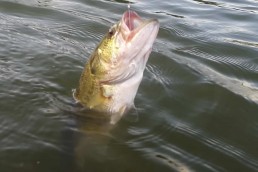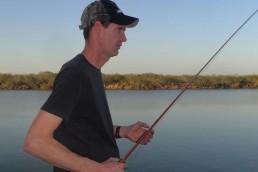Mallory on Bass
SHARE THIS POST
How’s that saying go? Give a man a fish and he’ll eat for a day; teach a man to fish and he’ll eat for a lifetime.
I was really lucky when growing up to have my dad and uncle take me fishing and, in some ways, extra fortunate that they were bass anglers, so I was able to learn how to catch bigger game soon after I learned the fundamentals.
I got started on the small stuff—bluegills, sunfish and what we used to call mud bass (actually warmouth bass)—and I think that’s the best way to get kids involved. Ideally, find a pond or a pier that’s full of them, and bait with something proven and not too difficult for a young kid to use.
Waxworms are usually available anywhere bait and tackle is sold in southern Michigan.
The idea of taking a kid fishing for the first time is to really listen to the kid and not force him or her to do anything they really don’t want to—it’s a big deal for a kid to impale a wriggly worm or even a fairly docile waxworm on a hook. If the kid doesn’t want to try and do it himself, do it for him, occasionally asking him after he catches a fish or a fish steals the bait from his hook if he wants to give it a try. If not, it’s no big deal.
It’s best to break fishing lessons down to small “chunks,” and casting bobbers with a split shot and a hook is probably the best way to start.
The rod you teach the kid with is important too—make it small and easy to handle. Push-button spincast combos are an easy-to-use rod and reel to start with when teaching those 4- and 5-year-olds. Older kids with bigger hands usually don’t have trouble with open-faced spinning reels and rods. And since that’s what even the little kids soon graduate to, you can start with those when teaching the school-aged youngsters.
When teaching casting, a good place to start is with a demonstration. Cast out a baited hook under a bobber just a short ways from shore and let it sit with the kid watching. In an ideal world, your pond or the water around the pier has fairly clear water where you and your student can watch panfish come and investigate the bait. Explain to the kid what’s happening, encouraging him to watch the bobber as the fish approaches the bait. Note how the bobber wiggles a little bit when the fish samples the bait, and maybe plummets when the fish grabs and runs. When the fish has the bait, set the hook lightly so the fish doesn’t come flying out of the water. Then help the kid get his hands on the reel. Let your pupil crank the fish to the bank and explain how he should be careful not to let the fish flop too much on the ground. Show how to hold the fish so the spines don’t poke you and take it off the hook. See if the kid wants to hold the fish and put it back in the water. If not, don’t make a big deal about that—just touching such a foreign creature can be a scary thing for kids. Just see if they want to touch the side of the fish with a finger. If not, again, just say “maybe the next one,” and put the fish back in the water yourself, noting how the fish swims away.
Are you enjoying this post?
You can be among the first to get the latest info on where to go, what to use and how to use it!
Now rebait (offering to let your little buddy do it, which he likely won’t), and now it’s the youngster’s turn to try and cast. Show him how to push the button of the reel and hold it so the line doesn’t come out. Now is time for one of the most important lessons: Show the kid how to watch the bobber and—especially—the hook as it goes around behind him in preparing to cast. Emphasize that when he or she starts fishing in different places, people might walk behind them and they need to always be careful with where that hook is. Explain that when they start fishing from a boat, other people will be very close by and can get hurt if they don’t pay attention to where the hook is. Don’t make it scary; just be matter-of-fact.
Now it’s time for the actual cast. Explain that when the rod comes in front of him, that’s the time to let go of the button but still hold on to the rod.
Kids usually catch on to this right away, perhaps because they have so much opportunity to push buttons on a video game controller. The first few casts aren’t going to be perfect. Even the first few trips worth of casting might not be perfect—unless you’ve got a young, Kevin VanDam-like fishing genius on your hands. That’s okay. Teaching kids anything, including fishing, is all about positive reinforcement. When the bobber and bait lands in the water, that’s reason for congratulations and praise.
Once the youngster gets fairly adept at catching panfish from shore, it’s time to introduce him or her to fishing from the boat, and depending on the kid’s skill level at casting and reeling, pursuing bass.
Of course you want to take all the safety precautions such as having the child wear an appropriate life jacket. The vest types are more comfortable than the classic orange life preservers, but make sure your student wears one. Put one on yourself to set a good example. Go over some safety concerns too about how to avoid falling in and appropriate boat behavior.
On that first boat lesson, it’s usually best if you don’t pick up your own rod right away, but just help the kid cast and retrieve so you’re there and ready when a tangle occurs or the lure gets stuck in some weeds, or if a fish bites.
This is the time to keep the lure selection simple. A Senko wacky-rigged with a circle hook (basically a straight, 4- or 5-inch worm hooked in the middle to wiggle on both ends) is hard to beat. The 4-incher will get more bites. I recommend rigging it with a circle hook, a 1/0 size, which will almost always hook a fish in the corner of its mouth without the kid needing to set it.
Tournament angler and avid outdoorsman, Buck Mallory, of Lawton, Mich., is a regular contributor to MidWest Outdoors, specializing in bass fishing.
MWO
SHARE THIS POST
Did you enjoy this post?
You can be among the first to get the latest info on where to go, what to use and how to use it!
Buck Mallory
Tournament angler and avid outdoorsman Buck Mallory of Lawton writes Michigan-specific bass fishing articles for MidWest Outdoors.



